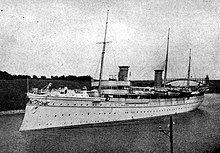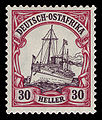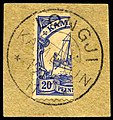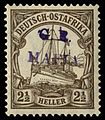Imperial yacht SMS Hohenzollern (stamp series)
The postage stamp series Kaiseryacht SMS Hohenzollern was a series of postage stamps of the German Reichspost with the image of the imperial yacht Hohenzollern built in 1892 , which was sold between 1900 and 1919 in the German colonies of German New Guinea , German East Africa , German South West Africa , Cameroon , Karoline Islands , Kiautschou , Mariana Islands , Marshall Islands , Samoa and Togo were issued.
history
The colonies were acquired by the German Empire between 1884 and 1899 . In the colonies the tariff system of the Deutsche Reichspost applied, whose postage stamps were also used in the colonies, initially the original issues of the Reichspost, from 1897 with an overprint of the name of the respective colony. In 1900, the postal stamp series with the image of the Kaiserjacht Hohenzollern and the name of the respective colony was introduced in all colonies .
The stamps were issued in different denominations between 3 pfennigs and 5 marks up to the beginning of the First World War . After the occupation of all German colonies by allied, mostly British , troops up to mid-1915, the stamps were overprinted with an imprint of the respective occupying power and continued to be used until the end of the war. The stamps also appear with the imprint "Specimen" (e.g. for presentation to the Universal Postal Union ).
Even after the Allied occupation of the German colonies, the stamp series remained on sale at the collector's counter in the main post office in Berlin. In the philatelic literature, 147 postage stamps from the colonies in the design of the Imperial Yacht series (and some overprint stamps from the foreign post offices) are referred to as a counter set, which were given there at face value upon request until the Treaty of Versailles was signed in June 1919. These included 23 brands from the Kaiseryacht series that never went on sale in the colonies. These stamps are issues on watermarked paper, new color variants or a changed country name (GERMAN-NEW GUINEA instead of GERMAN-NEW GUINEA). In the Michel catalog these issues are listed with their main numbers, although they could never be used for postal purposes. In the early 1920s, two previously unknown values from the Imperial Yacht series (East Africa, 2 rupees in light green, and Karolinen, 5 Pfennig green, on watermarked paper) came to light, which were officially auctioned from the archives of the Reichspost and in the catalog as " not spent ”with Roman numbers.
Germany lost its colonies under the Versailles Peace Treaty. This also ended the issue of colonial postage stamps by the Deutsche Reichspost.
Design and use
The postage stamp series consisted of two designs and formats, a smaller one for the penny values and a larger one for the mark values. The value grades and colors of the stamps were the same in all colonies.
The lower pfennig and mark values were monochrome (3 pfennigs - brown, 5 pfennigs - green, 10 pfennigs - pink, 20 pfennigs - blue, 1 mark - red, 2 marks - dark blue), the higher values (25, 30, 40, 50, 80 pfennig, 3 and 5 marks) multicolored. The color scheme thus largely corresponded to that of the Germania postage stamp series introduced in the Reich .
The stamps from East Africa had denominations in East African pesa currency (100 pesa = 1 rupee ) since 1893 and from 1905 onwards in hellers and rupees.
From 1900, the issues in Kiautschou initially bore pennies and marks, from 1905 the postage stamps were issued in Chinese dollar currency (100 cents = 1 dollar).
From 1905 onwards, all issues of the series were provided with a watermark (diamonds) as a security feature.
Penny values
The Pfennig issues have a format of 21 × 24 mm and a perforation of 14: 14.5. They show the Hohenzollern from the front, in a banner above the image of the ship is the name of the colony, under the picture the currency unit and on both sides of this the nominal value of the postage stamp. In the case of shorter colony names such as Togo or Samoa, an additional decorative element was provided in the banner on both sides of the name in capital letters in order to fill in empty spaces. The value grades of the Pfennig issues were uniformly 3, 5, 10, 20, 25, 30, 50 and 80 Pfennig for issues in German currency.
Market values
The horizontal format Mark issues have a format of 35 × 24 mm and, depending on the colony, a perforation of 26:17, 25:16 or 25:17. They show a side view of the Hohenzollerns , above which, as with the penny values, the colony name is located. At the bottom left and right is the nominal value with the currency information.
Halving and new value imprint
At the Ponape post office on the Karolinen, the 10-pfennig stamp was halved in 1905 after a typhoon destroyed part of the stamp inventory. In 1910, the 3-pfennig stamp was also given the 5 Pf hand stamp and the 10-pfennig stamp was halved, with the official seal added (so-called Ponape provisional). In 1911, in Cameroon, too, a halved 20-pfennig stamp was used with the addition of the official seal (Longji provisional).
Stamp booklet
Stamp booklets were issued (corresponding to the issues in the German Reich) for the colonies of Cameroon, German East Africa and German South West Africa.
Occupation expenses
After the occupation of the German colonies in the First World War, the postage stamps still found in the post offices with the designation of the respective occupying power and a new value in the currency of the occupying power were overprinted and used. The only exceptions are the stamps for the Caroline and Mariana Islands, which were destroyed by the Japanese occupiers under official supervision, as well as the stamps of the Kiautschou lease area, which were burned by the German defenders before the surrender.
Issues for German New Guinea, the Marshall Islands and Samoa were overprinted by the British with "GRI" (for "Georgius Rex Imperator" ), the initials of King George V. In Cameroon the imprint "CEF" was used for "Cameroon Expeditionary Force" . The stamps from Togo were overprinted with the words "TOGO Anglo French Occupation" (Togo Anglo-French occupation) and "TOGO Occupation franco-anglaise" (Togo French-English occupation) . For the island of Mafia , located off the coast of German East Africa, some values with the two-line blue hand-stamped “GRI MAFIA” were used in January 1915.
The crew issues are considered rarities among philatelists .
literature
- Walter Schießl / Günter Albinger: The sheet margin signatures of the colonial postage stamp issues Kaiserjacht "SMS Hohenzollern" 1900–1919
- Wolfgang Hermann: Writings on German Colonial Philately and Colonial History, Volume 7 - The Postal History of Samoa 1834-1919
General information:
-
Manual dictionary of the postal system ; 2nd Edition;
- Colonial postage stamps; P. 385
- Post in the formerly German protected areas; Pp. 528-530
- former German postal facilities abroad; Pp. 201-203
- Karl Sautter : German transport facilities abroad and in the protected areas in: History of the Deutsche Post - Part 3 - History of the Deutsche Reichspost (1871 to 1945); Federal Printing Office Frankfurt am Main, 1951; Pp. 293-295
- German Postal History; 1937/38, Peglow
- German Post Archive 1921; No. 10 and 11
- Lemma postage stamps , in Deutsches Kolonial-Lexikon (1920), Volume III, p. 94 f.
Web links
- Working group for colonial postage stamps of the Association of German Philatelists
- Colonial issues of Marshal Islands postage stamps
Individual evidence
- ↑ Ullrich Häger: Large Lexicon of Philately. P. 416, Bertelsmann, Gütersloh 1973, ISBN 3-570-03229-9 .
- ^ Michel catalog: Europe . Schwaneberger-Verlag, Munich 1957.
- ^ Michel catalog Germany Special 1983/1984, p. 954 f.
- ↑ Michel catalog Germany Special 1983/1984, p. 953.
- ↑ Michel catalog Germany Special 1983/1984 p. 969 ff.
- ^ B. Armstrong, Charles H. Greenwood: War Stamps of the Allies 1914-1920. A historical record. London, 96 p. ( Page no longer available , search in web archives ) Info: The link was automatically marked as defective. Please check the link according to the instructions and then remove this notice.
























